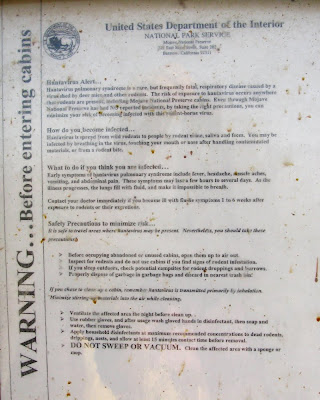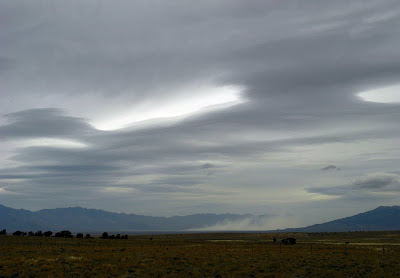 The morning of the third day dawned cloudy, with very nice lighting. I enjoyed the chill air, and walked around downtown KFalls while drinking coffee from a tiny styrofoam cup provided by the motel office. After several cupfuls, I finally got underway and headed north on Highway 97, which is now being called The Dalles-California Highway. I've always called Highway 97 in Oregon "The Bend Highway" - because it goes through Bend - and personally think that any highway running through Oregon should not be allowed to have the word "California" attached to it. I say this as a bred (barely) and born Oregonian.
The morning of the third day dawned cloudy, with very nice lighting. I enjoyed the chill air, and walked around downtown KFalls while drinking coffee from a tiny styrofoam cup provided by the motel office. After several cupfuls, I finally got underway and headed north on Highway 97, which is now being called The Dalles-California Highway. I've always called Highway 97 in Oregon "The Bend Highway" - because it goes through Bend - and personally think that any highway running through Oregon should not be allowed to have the word "California" attached to it. I say this as a bred (barely) and born Oregonian. Along the road, just barely north of town, you will come to a roadcut with some bright, white rocks (Google Maps location). I remember this roadcut from a very long time ago, when I was a young girl growing up in California (yes, the ignominy of it all). We traveled to Oregon at least yearly, often on this highway. A diatomite mine, now inactive, sits along the side of the highway just south of this roadcut - if I remember right. I didn't find an online reference to the old mine.
Along the road, just barely north of town, you will come to a roadcut with some bright, white rocks (Google Maps location). I remember this roadcut from a very long time ago, when I was a young girl growing up in California (yes, the ignominy of it all). We traveled to Oregon at least yearly, often on this highway. A diatomite mine, now inactive, sits along the side of the highway just south of this roadcut - if I remember right. I didn't find an online reference to the old mine. This is one of my favorite roadcuts. When I first drove the highway myself in 1975, I remembered the rocks from decades past. The white, diatomaceous lake sediments or mudstones of late Miocene to Pliocene age are overlain by a basalt flow (geologic map). You can see the upright columnar jointing in the flow.
This is one of my favorite roadcuts. When I first drove the highway myself in 1975, I remembered the rocks from decades past. The white, diatomaceous lake sediments or mudstones of late Miocene to Pliocene age are overlain by a basalt flow (geologic map). You can see the upright columnar jointing in the flow.Somewhere, in a box in some garage in Alaska, there might be a very old hand sample from this roadcut. Maybe.
 Just around the corner to the north, Highway 97 goes into a straight stretch, pointing straight at several exposures of young-looking fault scarps belonging to the East Klamath Lake Fault Zone. The zone is seismically active. This article makes it look like there was a 1947 earthquake along or just north of the mapped zone, and this CVO page discusses the West and East Klamath Fault Zones in relation to Crater Lake and historic earthquakes. The fault can be seen in the large cinder/gravel mine to the right of the highway - which is accessible when it isn't active - and it can be seen in a very good and accessible exposure on the same hillside, just left of where the highway is pointing in the above photo.
Just around the corner to the north, Highway 97 goes into a straight stretch, pointing straight at several exposures of young-looking fault scarps belonging to the East Klamath Lake Fault Zone. The zone is seismically active. This article makes it look like there was a 1947 earthquake along or just north of the mapped zone, and this CVO page discusses the West and East Klamath Fault Zones in relation to Crater Lake and historic earthquakes. The fault can be seen in the large cinder/gravel mine to the right of the highway - which is accessible when it isn't active - and it can be seen in a very good and accessible exposure on the same hillside, just left of where the highway is pointing in the above photo. To get to the best exposure I've seen, turn right on this paved road, then immediately turn left into the gravel ramp and old road seen in the center of the photo beyond the paved road. You can park somewhere along the old road, and then walk to the scarp.
To get to the best exposure I've seen, turn right on this paved road, then immediately turn left into the gravel ramp and old road seen in the center of the photo beyond the paved road. You can park somewhere along the old road, and then walk to the scarp. This exposure of the fault scarp (Google Maps location) is accessible with some hiking up the steep slope. I didn't hike up this time, but have on previous occasions. I've also poked around the cinder/gravel mine, a few years back when it was closed. The fault places bedrock of basaltic cinders and possible flows against somewhat reddish older alluvium. It looked to me like younger, lighter brown talus was not offset by the fault. The fault surface is smooth, grooved, and slickensided, and compares favorably to the Genoa fault scarp south of Carson City for a great fault exposure.
This exposure of the fault scarp (Google Maps location) is accessible with some hiking up the steep slope. I didn't hike up this time, but have on previous occasions. I've also poked around the cinder/gravel mine, a few years back when it was closed. The fault places bedrock of basaltic cinders and possible flows against somewhat reddish older alluvium. It looked to me like younger, lighter brown talus was not offset by the fault. The fault surface is smooth, grooved, and slickensided, and compares favorably to the Genoa fault scarp south of Carson City for a great fault exposure.I have some old non-digital photos of this Klamath Basin fault surface, and will surely scan them someday.
 Fault surfaces are visible along the highway for several miles, mostly in areas where rocks are kept behind barriers and metal screens. The road is narrow, often with curves, and it cuts into a steep, talus-ridden hillside. Traffic is often incessant. There are a few small pullouts on the southbound side of the road - these are hard to stop in because they are so short. They also precipitously overhang the railroad, which is below the highway closer to the lake. I've stopped at one or two of these pullouts; they don't really provide very good access to the roadcuts.
Fault surfaces are visible along the highway for several miles, mostly in areas where rocks are kept behind barriers and metal screens. The road is narrow, often with curves, and it cuts into a steep, talus-ridden hillside. Traffic is often incessant. There are a few small pullouts on the southbound side of the road - these are hard to stop in because they are so short. They also precipitously overhang the railroad, which is below the highway closer to the lake. I've stopped at one or two of these pullouts; they don't really provide very good access to the roadcuts. At this pullout on the east side of Highway 97, you can look across Upper Klamath Lake and see several volcanoes. It was a bit cloudy, so I got decent photos of only two, Mount Harriman, above, and Pelican Butte, below. Mount Harriman is one of four (or more?) shield volcanoes inside the Mountain Lakes Wilderness. Pelican Butte is a shield volcano just northeast of Mount McLoughlin.
At this pullout on the east side of Highway 97, you can look across Upper Klamath Lake and see several volcanoes. It was a bit cloudy, so I got decent photos of only two, Mount Harriman, above, and Pelican Butte, below. Mount Harriman is one of four (or more?) shield volcanoes inside the Mountain Lakes Wilderness. Pelican Butte is a shield volcano just northeast of Mount McLoughlin.
 Just up the road apiece, I saw these signs, and made a sudden, unplanned side trip... to Crater Lake.
Just up the road apiece, I saw these signs, and made a sudden, unplanned side trip... to Crater Lake.A Reference:
Priest, G. R., Hladky, F. R., and Murray, R. B., 2008, Geologic Map of the Klamath Falls area, Klamath County, Oregon: State of Oregon Dept. of Geol. and Mineral Resources, Map GMS-118.








































